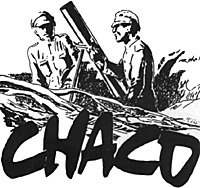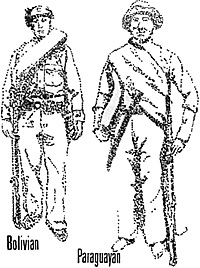
Title: CHACO
Price: $6.80
Source: Game Designers' Workshop, P.O. Box 582, Bloomington, Illinois, 61701.
Subject: The War between Bolivia and Paraguay, 1932-35.
Designer: Marc William Miller
One receives a 24" by 28" unmounted two color hexagon map of the Bolivian/Paraguayan theater of operations. Most of this region is "El Gran Chaco." The entire board stretches from Santa Cruz to Asuncion, has cities, mountains, oil fields, roads, swamps, railroads, and a special Mennonite colony which, if violated by the Bolivians, costs the Paraguayans two victory points.
One also receives a set of instructions, several playing aid sheets, a combat results table, a terrain effects sheet, and several hundred die-cut mounted counters. There is an extensive and humorous set of designer notes as well as an excellent bibliography.
This latter is of great value. One can go on from it to learn more about the campaign. Admittedly this is an obscure campaign so I am unqualified to pass judgement upon the designer's research, but this item gives one a feeling that adequate work was done. Further, if a bibliography were to be included with all games then one could more easily discover the weaknesses (if any) of the designer's approach.
 This simulation is one of "classic infantry warfare" between Paraguay and Bolivia. The
basic unit is the infantry regiment and though you are given many units, no more than 1/3rd are ever employed at one time, and usually it is a quite smaller number.
This simulation is one of "classic infantry warfare" between Paraguay and Bolivia. The
basic unit is the infantry regiment and though you are given many units, no more than 1/3rd are ever employed at one time, and usually it is a quite smaller number.
All units can be combined to form higher level organizations up to the Corps level. Though either army is basically infantry oriented, there are air units, cavalry (which is infantry with easy-to-kill horses), artillery, two Paraguayan gunboats, engineers, and some Bolivian tank units. Both players may use truck and horse units and the Paraguayans may constitute a motorized division. To round out the simulation there is a third player "Tell it to the Marines" intervention scenario. This calls for FDR to throw the Marines (recently back from chasing Sandino) into Bolivia and/or Paraguay (transported by the airships Macon and Akron no less) to end the fighting!
The average Paraguayan regiment is worth 4 combat factors while the Bolivian reciments are worth 3. A Marine battalion is worth 8 combat factors!
The physical look of the game is quite nice; it almost appears as if Simonsen with his somber colors had prepared the pieces and board. Chaco is definitely a professional presentation. The rules are not clear on a few points but otherwise are quite adequate. Game length is seven turns and goes quite adequate. Game length is seven turns and goes quite quickly, approximately two-three hours game play.
During the game both sides get to attack. The Bolivians dominate the first two turns but the tide slowly begins to turn as the Paraguayans receive more and faster-arriving reinforcements, thereby slowly gaining the initiative. The basic Paraguayan strategy is to gain as much territory as he can with as few losses as possible. The Bolivian strategy is to sieze and hold, regardless of losses.
Victory points depend on territory and losses. However, losses are geared to population size, which means 1 dead Paraguayan hurts more than 1 dead Bolivian. Victory is simply more points than the other side; it is not graduated between tactical or strategic victory.
Chaco will be a near classic game. It is short and exciting with both sides getting options to attack and having the ability to shift troops quickly from one front to another during the six-month-long turns. If one side gets a breakthrough then one can push troops way behind the enemy lines. This game appears to be well researched, and is semi-rigidly historical in presentation. That is to say, Chaco and the Game Designers' Workshop appear more akin to the philosophy of SPI than say a classic Avalon Hill or Conflict Game Company game. Which is why it will not be a classic, only nearly so.
To give just two examples of historical vs. playability approach: automatic victory is such that one can make a few special dispositions and slow the enemy's advances, which gives one the correct historical feel of a semi-World War I mentality; since there is no graduated victory, if one side or the other gets into a desperate position then he might as well surrender. What this means is that while historically accurate, a certain degree of playability is lost that makes a truly playable and "fun" game that a classic must be.
To sum up, I think that at present, an excellent historical game (which Chaco is) can not be put in the playability format of say Afrika Korp or Waterloo.
Let me end this with one final thought. Considering the large number of "average (a synonym for crap) games on the market these days, and the fact that the wargaming hobby is lucky if it gets one "classic" a year, being a near-classic is a good buy.
Back to Table of Contents -- Panzerfaust #62
To Panzerfaust/Campaign List of Issues
Back to MagWeb Master Magazine List
© Copyright 1974 by Donald S. Lowry
This article appears in MagWeb (Magazine Web) on the Internet World Wide Web. Other military history articles and gaming articles are available at http://www.magweb.com